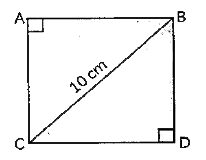If one vertex of a square whose diagonals intersect at the origin is , then find the two adjacent vertices.
Video Solution
|
Answer
Step by step video & image solution for If one vertex of a square whose diagonals intersect at the origin is 3(costheta+isintheta) , then find the two adjacent vertices. by Maths experts to help you in doubts & scoring excellent marks in Class 11 exams.
Updated on:21/07/2023Similar Questions
Knowledge Check
If one vertex of a square whose diagonals intersect at the origin is 3(cosθ+isinθ) , then find the two adjacent vertices.
A±(sinθ+icosθ)B±(cosθ−isinθ)C±3(sinθ−icosθ)DnoneFind the side of a square whose diagonal is 10 cm.
 A5√2cmB10√2cmC5cmD10cm
A5√2cmB10√2cmC5cmD10cmFind the area of a square whose diagonal is half of 12cm.
A18 sq. cm.B64 sq. cm.C36 sq. cm.D72 sq. cm.
Find the area of square whose diagonal.is 5√2 cm
View SolutionFind the area of a square, one of whose diagonals is 3.8 m long.
View SolutionFind the side of a square whose diagonal is 16√2cm.
View SolutionFind the side of the square whose diagonal is 16√2cm.
View SolutionConstruct a square whose one diagonal AC=6.8cm.
View Solution
